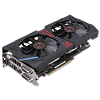 96
96
ASUS Radeon R9 380X Strix 4GB Review
Packaging & Contents »Introduction

AMD's latest attempt to win a critical sub-$300 price-performance sweet-spot is the Radeon R9 380X, launched today. It capitalizes on a gaping hole in NVIDIA's rivaling product stack set between the $170 GeForce GTX 960 and the $290 GTX 970 with nothing in between. Gamers could benefit from an option somewhere in the middle that lets them max out settings at 1080p, and perhaps even tinker with the higher 1440p resolution at moderately high settings.
The Radeon R9 380X is based on the same silicon as the R9 380, codenamed "Antigua," a rehashed "Tonga" which drives the R9 285. This chip is technologically more up-to-date than the Hawaii-based R9 390 series since it features the company's latest Graphics CoreNext (GCN) 1.2 stream processors. The R9 380X features all 32 GCN compute units physically present on the silicon, which amounts to 2,048 stream processors in total. That also entails a TMU count of 128. There are 32 ROP units and a 256-bit wide GDDR5 memory interface. 4 GB is the standard memory amount for this SKU, and there won't be a 2 GB variant. AMD is pricing this card as low as $229, which definitely puts a lot of pressure on the GTX 960.

In this review, we're testing the ASUS Radeon R9 380X STRIX based on the company's iconic 0 dBA-ready DirectCU II cooling solution, which can turn its fans off below a specific temperature threshold and promises very low noise levels under load. The card comes overclocked out of the box to a GPU clock of 1030 MHz and memory has remained at the AMD default of 1425 MHz. The ASUS R9 380 STRIX is expected to retail at $240, while the reference-clocked Radeon R9 380X variants will retail at around $230.
| GeForce GTX 960 | Radeon R9 285 | Radeon R9 380 | GeForce GTX 770 | Radeon R9 280X | Radeon R9 380X | ASUS R9 380X STRIX | GeForce GTX 780 | Radeon R9 290 | Radeon R9 390 | GeForce GTX 970 | |
|---|---|---|---|---|---|---|---|---|---|---|---|
| Shader Units | 1024 | 1792 | 1792 | 1536 | 2048 | 2048 | 2048 | 2304 | 2560 | 2560 | 1664 |
| ROPs | 32 | 32 | 32 | 32 | 32 | 32 | 32 | 48 | 64 | 64 | 56 |
| Graphics Processor | GM206 | Tonga | Tonga | GK104 | Tahiti | Tonga | Tonga | GK110 | Hawaii | Hawaii | GM204 |
| Transistors | 2940M | 5000M | 5000M | 3500M | 4310M | 5000M | 5000M | 7100M | 6200M | 6200M | 5200M |
| Memory Size | 2048 MB | 2048 MB | 2048 MB | 2048 MB | 3072 MB | 4096 MB | 4096 MB | 3072 MB | 4096 MB | 8192 MB | 4096 MB |
| Memory Bus Width | 128 bit | 256 bit | 256 bit | 256 bit | 384 bit | 256 bit | 256 bit | 384 bit | 512 bit | 512 bit | 256 bit |
| Core Clock | 1127 MHz+ | 918 MHz | 970 MHz | 1046 MHz+ | 1000 MHz | 970 MHz | 1030 MHz | 863 MHz+ | 947 MHz | 1000 MHz | 1051 MHz+ |
| Memory Clock | 1753 MHz | 1375 MHz | 1375 MHz | 1753 MHz | 1500 MHz | 1425 MHz | 1425 MHz | 1502 MHz | 1250 MHz | 1500 MHz | 1750 MHz |
| Price | $170 | $180 | $180 | $300 | $220 | $230 | $240 | $290 | $240 | $330 | $290 |
Apr 25th, 2024 18:49 EDT
change timezone
Latest GPU Drivers
New Forum Posts
- BSOD if I touch the pcache offset voltage in throttlestop (i9-13900hx lenovo pro 7i) (23)
- Alphacool CORE 1 CPU block - bulging with danger of splitting? (16)
- Core PL1 + GPU PL1 + Ring EDP OTHER (7)
- How to check flatness of CPUs and coolers - INK and OPTICAL INTERFERENCE methods (112)
- Best SSD for system drive (78)
- Which new games will you be buying? (314)
- TPU's Nostalgic Hardware Club (18464)
- Post your Cinebench 2024 score (450)
- Ubuntu 24.04 LTS released (2)
- Dell Workstation Owners Club (3054)
Popular Reviews
- Fractal Design Terra Review
- Thermalright Phantom Spirit 120 EVO Review
- Corsair 2000D Airflow Review
- Minisforum EliteMini UM780 XTX (AMD Ryzen 7 7840HS) Review
- ASUS GeForce RTX 4090 STRIX OC Review
- NVIDIA GeForce RTX 4090 Founders Edition Review - Impressive Performance
- ASUS GeForce RTX 4090 Matrix Platinum Review - The RTX 4090 Ti
- MSI GeForce RTX 4090 Suprim X Review
- MSI GeForce RTX 4090 Gaming X Trio Review
- Gigabyte GeForce RTX 4090 Gaming OC Review
Controversial News Posts
- Sony PlayStation 5 Pro Specifications Confirmed, Console Arrives Before Holidays (117)
- Windows 11 Now Officially Adware as Microsoft Embeds Ads in the Start Menu (106)
- NVIDIA Points Intel Raptor Lake CPU Users to Get Help from Intel Amid System Instability Issues (106)
- AMD "Strix Halo" Zen 5 Mobile Processor Pictured: Chiplet-based, Uses 256-bit LPDDR5X (101)
- US Government Wants Nuclear Plants to Offload AI Data Center Expansion (98)
- AMD's RDNA 4 GPUs Could Stick with 18 Gbps GDDR6 Memory (87)
- Developers of Outpost Infinity Siege Recommend Underclocking i9-13900K and i9-14900K for Stability on Machines with RTX 4090 (85)
- Windows 10 Security Updates to Cost $61 After 2025, $427 by 2028 (84)